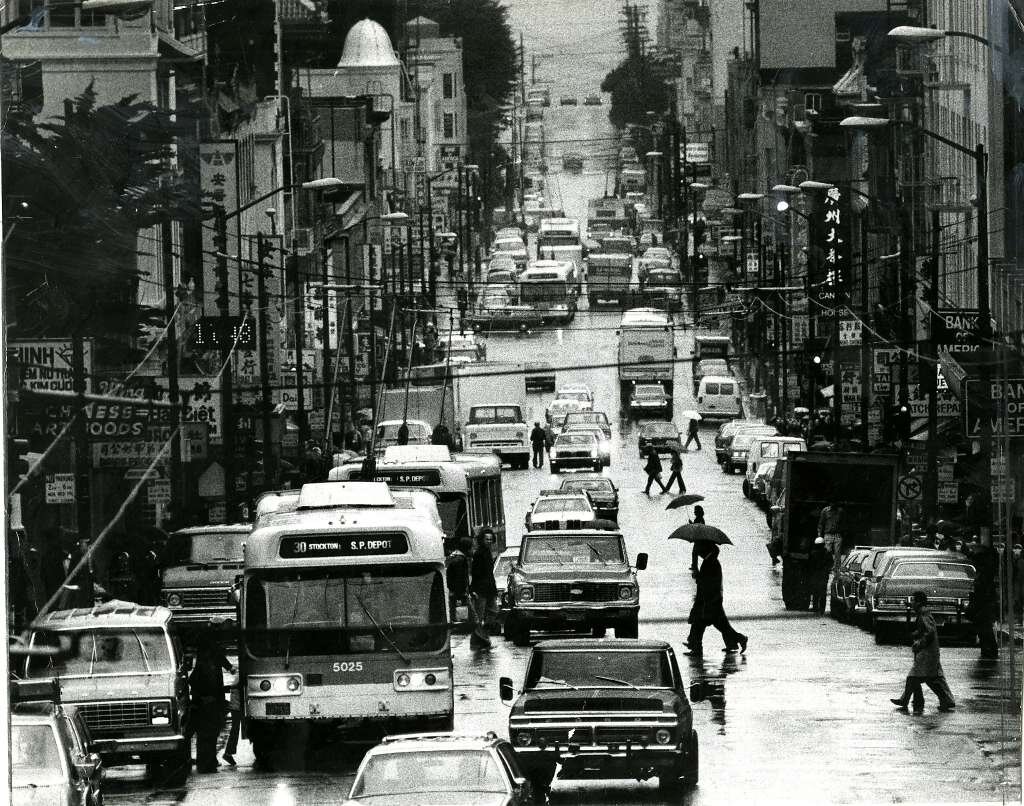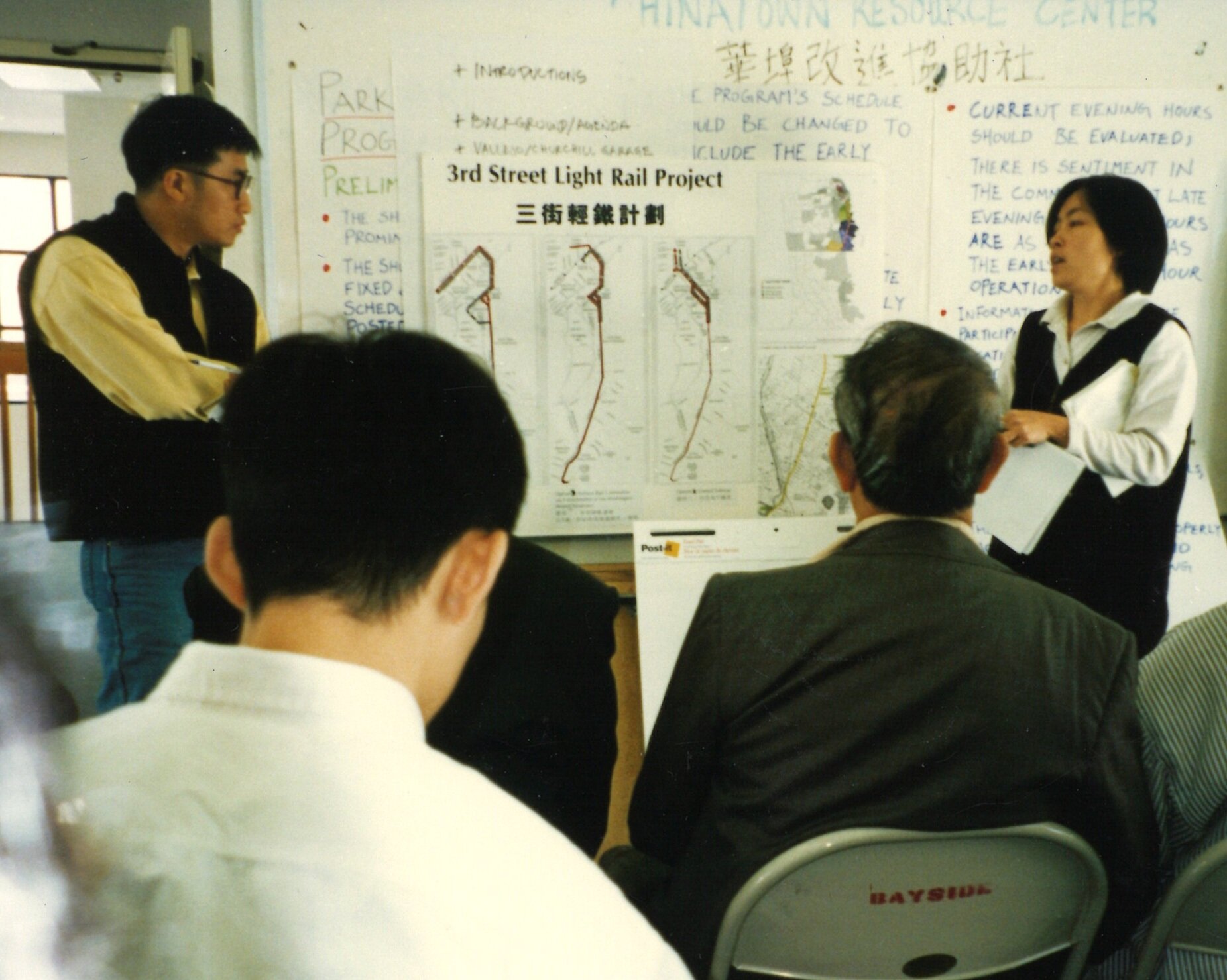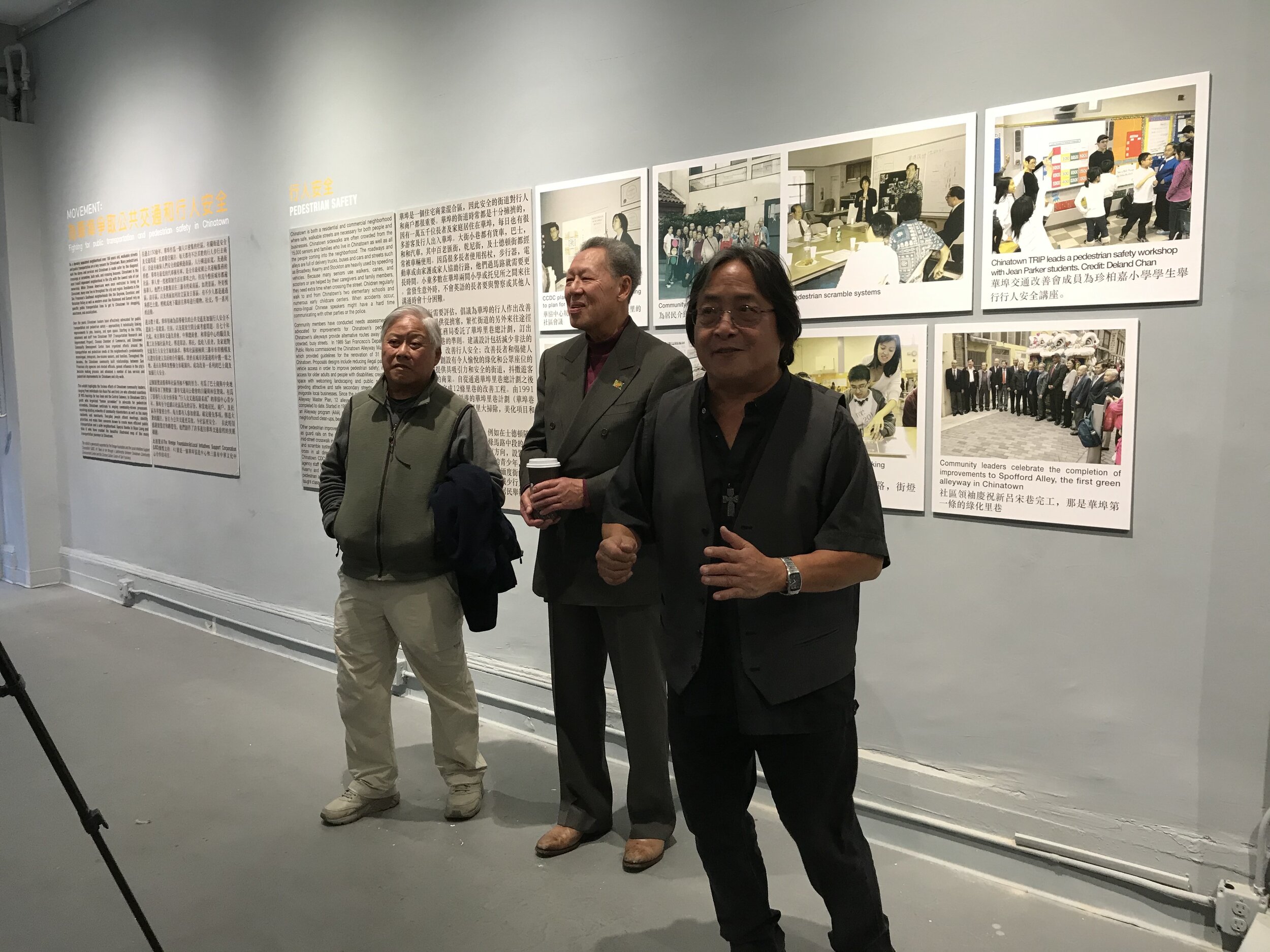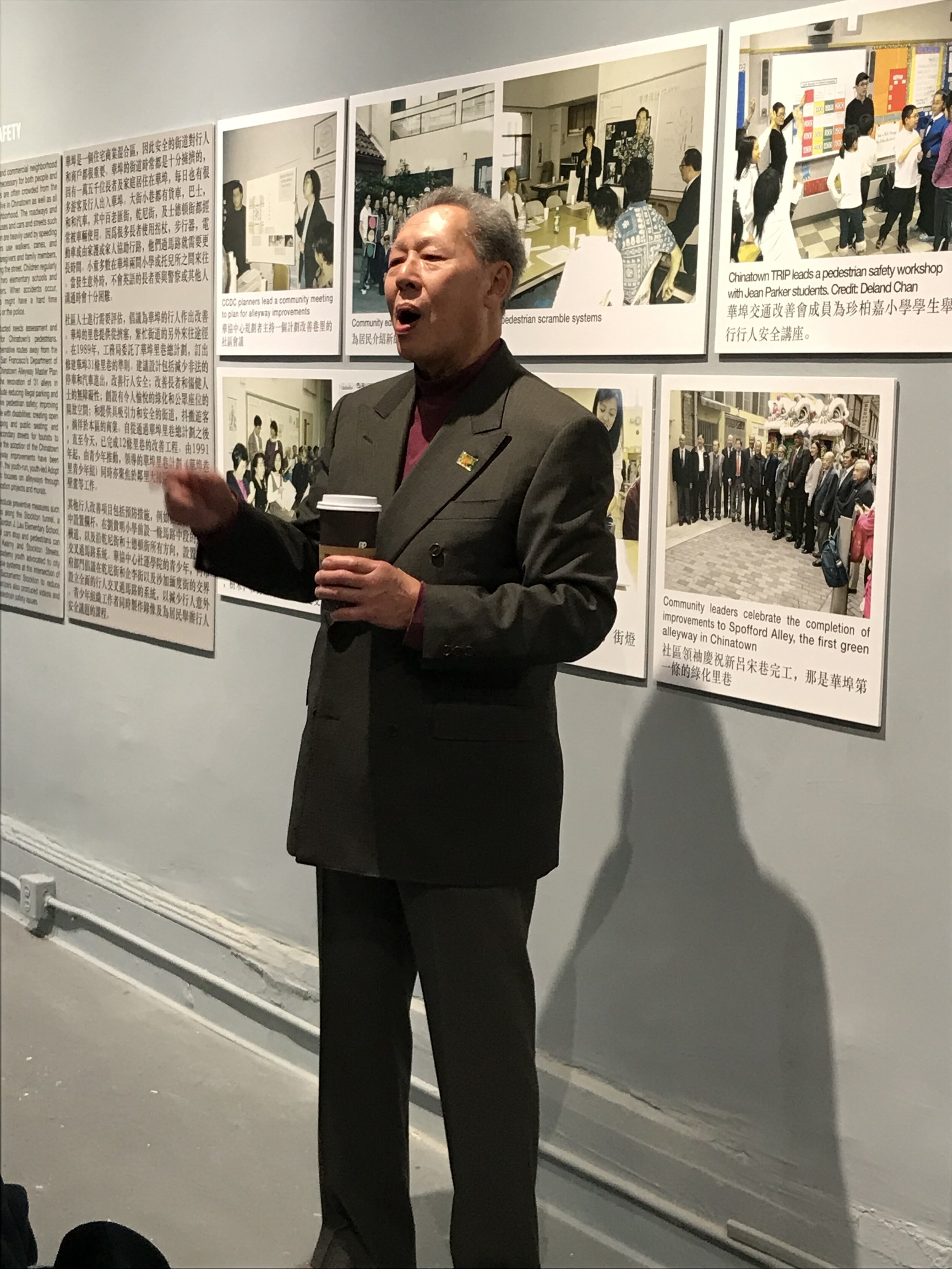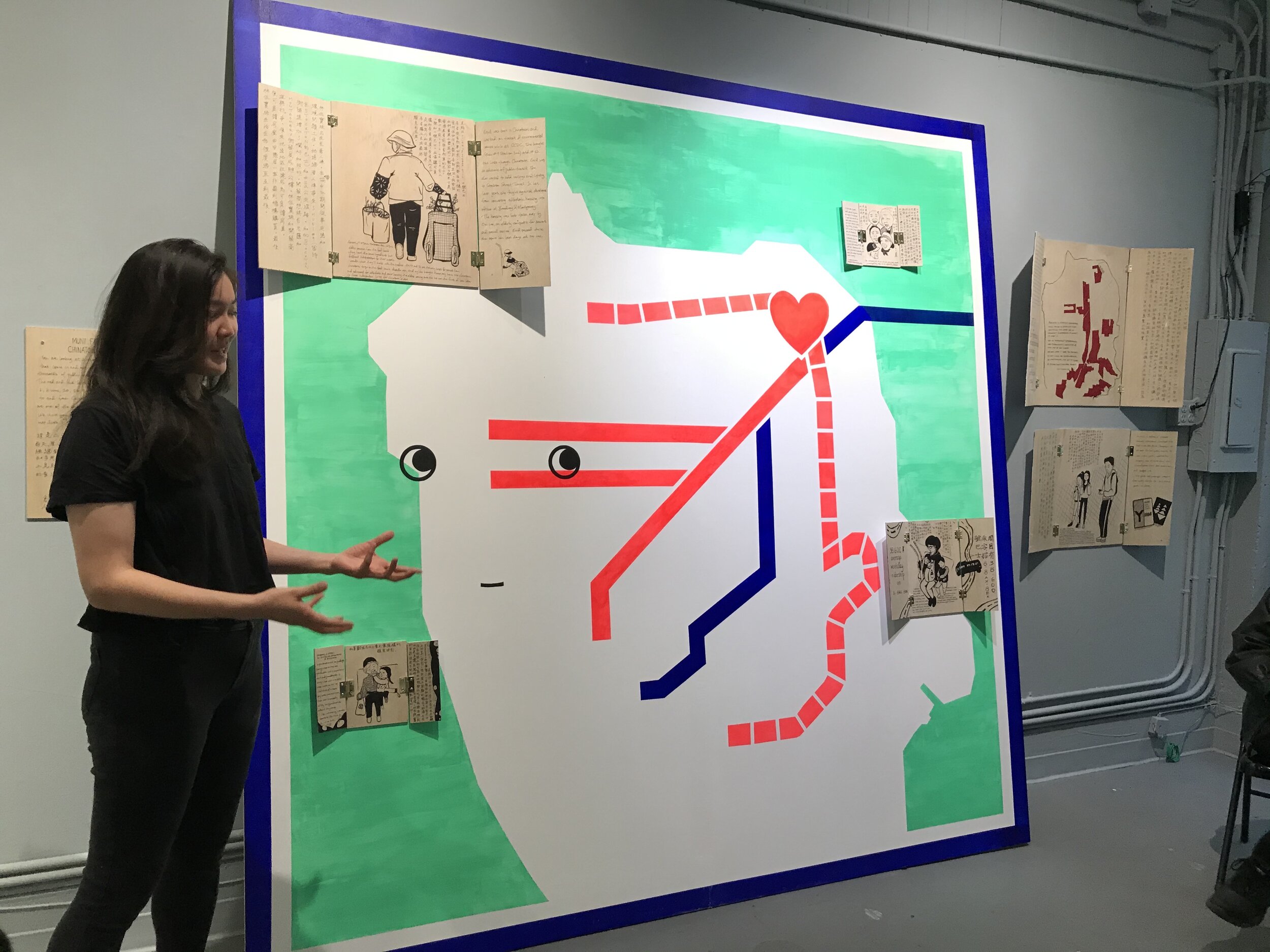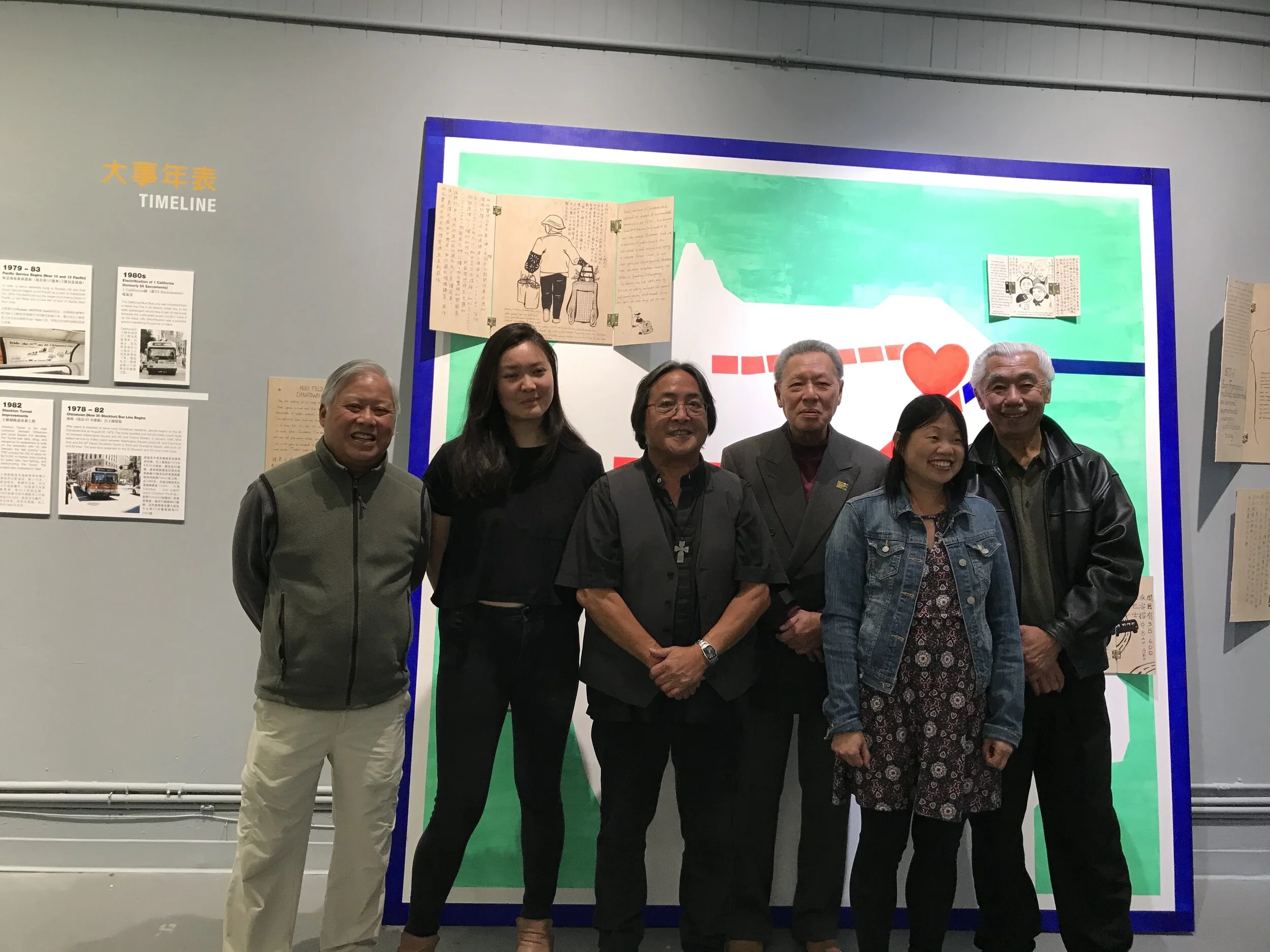Movement: Transportation Justice in Chinatown 為華埠爭取公共交通和行人安全
Movement: Transportation Justice in Chinatown 為華埠爭取公共交通和行人安全 highlights the tireless efforts of Chinatown community leaders including individuals like Rose Pak and Enid Lim for pedestrian safety and public transportation before and after the earthquake.
「心繫華埠」展示華埠當地商店如何用他們獨特的商品在顧客的每日生活和特殊節日裡扮演重要的角色。
41 Ross EXHIBITION DATES
october 3rd - november 30th, 2019
About the show
Chinatown’s walkable streets and public transportation are key concerns for a densely populated neighborhood over 150 years old. Countless pedestrians walk to stores and services and the diagonal crossings or scrambles, bulb outs, and crossing beacons help keep them safe. Chinatown is the most transit dependent neighborhood in the city with the lowest rate of car ownership. While Chinese Americans were once restricted to living in Chinatown, many now live throughout the city and region. Residents in San Francisco’s Southeast neighborhoods like the Bayview, Excelsior, and Visitation Valley as well as western areas like the Richmond and Sunset rely on specific public transportation lines to get to Chinatown for shopping, assistance, and socialization.
Over the years, Chinatown leaders have effectively advocated for public transportation and pedestrian safety – approaching it holistically, linking improvements to jobs, housing, and open space. Starting in the 1970s, volunteers and staff from Chinatown TRIP (Transportation Research and Improvement Project), Chinese Chamber of Commerce, and Chinatown Community Development Center have organized efforts around the transportation and pedestrian needs of the neighborhood’s predominantly monolingual, immigrant, low-income seniors and families. Throughout the decades, the Chinatown community built relationships between San Francisco city agencies and elected officials, gained influence in the city’s decision making process, and advanced a number of bus service and pedestrian improvements for Chinatown and city-wide.
This exhibit highlights the tireless efforts of Chinatown community leaders, ranging from individuals like Rose Pak and Enid Lim who attended countless San Francisco Municipal Transportation Agency (SFMTA) hearings for bus lines and the Central Subway, to Chinatown CDC’s youth who organized “human scrambles” to advocate for pedestrian scrambles. Chinatown continues to employ community-driven processes involving existing networks of community stakeholders as well as the many residents and merchants. Everyday people attend meetings, identify priorities, and make their concerns known to create more efficient public transportation and a safer neighborhood. Special thanks to Bijan Liang and Vida K who have created the beautiful illustrated map of the many transportation journeys to Chinatown.
This exhibit is generously supported by The Kresge Foundation and the Local Initiatives Support Corporation (LISC). 41 Ross is run through a partnership between Chinatown Community Development Center and the Chinese Culture Center of San Francisco.
在過去150餘年,華埠作爲一個人口密集的社區,有關街道安全及交通問題一直都備受關注。每天都有不計其數的行人步行去商店,沿途有確保人們安全的縱橫過街區,人行橫道拓寬,及過街燈標。華埠有最低的汽車擁有率,是全市最依賴公共運輸服務的社區。華人曾一度被限制生活在華埠之内,但現今整座城市都遍佈華人,他們大多數聚居在三藩市的東南區,如灣景區,外美慎區,訪谷區,以及西面如列治文區及日落區。有不少人都是通過乘搭巴士綫,輕軌或地下鐵前往華埠進行購物,社交,等一系列的活動。
過去數十載,華埠領袖為倡導優良的公共交通及加强行人安全不遺餘力 -- 從就業,住屋,以及開放空間全面考慮問題。自七十年代起,來自華埠交通改善會,中華總商會, 和華協中心的職員及義工在各個社區奔走,傳達單語,移民,低收入長者,及家庭對交通及行人安全方面的訴求。華埠社區積極與三藩市市府機構及民選官員建立良好的合作關係,終於在城市決策過程中獲一席之地,過去在華埠及整個全市範圍内,成功改善一系列的巴士綫及加强行人安全。
這個展覽表揚華埠社區領袖不懈的努力,有爲了巴士綫與中央地鐵而參加了無數個三藩市交通局公聽會的白蘭與林伍寶珠,有爲了倡導行人安全而爭取“行人交叉過馬路系統”的華協中心青少年。華埠至今延續以社區爲先的宗旨,和當地居民,商戶,及社區各界緊密合作。每天都有人參加會議,確定優先事項,傳達大衆的關注,旨在令公共交通更高效,令社區更安全。 在此特別感謝梁璧君和鄺蹵瑩,他們創作了許多通往華埠交通旅程的美麗插圖。
此展覽承The Kresge Foundation和Local Initiatives Support Corporation (LISC)慷慨支持。41 號 是一個華埠協進中心和三藩市中華文化中心合作的項目。
Pedestrian Safety
Ped Safe Jean Parker
Chinatown is both a residential and commercial neighborhood where safe, walkable streets are necessary for both people and businesses. Chinatown sidewalks are often crowded from the 15,000 seniors and families who live in Chinatown as well as all the people coming into the neighborhood. The roadways and alleys are full of delivery trucks, buses and cars and streets such as Broadway, Kearny and Stockton are heavily used by speeding vehicles. Because many seniors use walkers, canes, and scooters or are helped by their caregivers and family members, they need extra time when crossing the street. Children regularly walk to and from Chinatown’s two elementary schools and numerous early childcare centers. When accidents occur, mono-lingual Chinese speakers might have a hard time communicating with other parties or the police.
Ped Safe Scramble Education
Community members have conducted needs assessment and advocated for improvements for Chinatown’s pedestrians. Chinatown’s alleyways provide alternative routes away from the crowded, busy streets. In 1989 San Francisco’s Department of Public Works commissioned the Chinatown Alleyway Master Plan which provided guidelines for the renovation of 31 alleys in Chinatown. Proposals designs include reducing illegal parking and vehicle access in order to improve pedestrian safety; improving access for older adults and people with disabilities; creating open space with welcoming landscaping and public seating; and providing attractive and safe secondary streets for tourists to invigorate local businesses. Since the adoption of the Chinatown Alleyway Master Plan, 12 alleyway improvements have been completed to date. Started in 1991, the youth-run, youth-led Adopt an Alleyway program (AAA) also focuses on alleyways through neighborhood clean-ups, beautification projects and murals.
Ped Safe Scramble
Other pedestrian improvements include preventive measures such as guard rails on the sidewalks along the Stockton tunnel, a mid-street crosswalk in front of Gordon J. Lau Elementary School, and scramble systems where all cars stop and pedestrians can cross in all directions along Kearny and Stockton Streets. Chinatown CDC’s Campaign Academy youth advocated to city agency staff to install full scramble systems at the intersection of Kearny and Clay Streets and Sacramento Stockton to reduce pedestrian accidents. Youth organizers also produced videos and taught classes to residents on pedestrian safety issues.
行人安全
華埠是一個住宅商業混合區,因此安全的街道對行人和商戶都很重要。華埠的街道時常都是十分擁擠的,因有一萬五千位長者及家庭居住在華埠,每日也有很多游客及行人出入華埠。大街小巷都有貨車,巴士,和和汽車,其中百老匯街,乾尼街,及士德頓街都經常被車輛使用。因爲很多長者使用拐杖,步行器,電動車或由家護或家人協助行路,他們過馬路就需要更長時間。小童多數在華埠兩間小學或托兒所之間來往。當發生意外時,不會英語的長者要與警察或其他人溝通時會十分困難。
社區人士進行需要評估,倡議為華埠的行人作出改善。華埠的里巷提供從擠塞,繁忙街道的另外來往途徑。在1989年,工務局委託了華埠里巷總計劃,訂出修建華埠31條里巷的準則。建議設計包括減少非法的停車和汽車進出,改善行人安全;改善長者和傷健人士的無障礙性;創設有令人愉悅的綠化和公眾座位的開放空間;和提供具吸引力和安全的街道,抖擻遊客,徜徉於本區的商業。自從通過華埠里巷總計劃之後,直至今天,已完成12條里巷的改善工程。由1991年起,由青少年推動,領導的華埠里巷計劃(華埠巷里青少年組)同時亦聚焦於鄰里大掃除,美化項目和壁畫等工作。
其他行人改善項目包括預防措施,例如在士德頓隧道中設置欄杆、在劉貴明小學前設一條馬路中段的人行橫道,以及沿乾尼街和士德頓街所有方向,設置行人交叉過馬路系統。華協中心社運學院的青少年,向市府部門倡議在乾尼街和企李街以及沙加緬度街的交界設立全面的行人交叉過馬路的系統,以減少行人意外。青少年組織工作者同時製作錄像及為居民舉辦行人安全議題的課程。
Buses and Transit
Buses on Stockton Street on rainy day
One bus driver saying is “Just drive the outside the bus.” For safe driving, muni operators are told to focus on what’s happening on the street, rather than what’s happening inside the bus at the same time. SFMTA started hiring of Chinese as motormen and conductors at the end of World War ll. The next largest wave of Chinese Muni bus operators were from the boomer generation, hired in the 1970s after Asian Americans demanded affirmative action. Many were educated and college graduates. These bus drivers did more than just drive the bus, and also advocated for the needs of Chinatown’s residents. They witnessed how bus lines did not serve or skipped stops full of Chinatown residents. Their inside knowledge of driving buses and routes were essential when pressing SFMTA for new stops, service routes and boarding practices.
In 1976 the San Francisco Craft Workers’ Strike led to a Muni service lockout. Many elderly in Chinatown still needed transportation to meet their daily needs such as getting to medical appointments. To support these residents, community members developed the Chinatown Transportation Research and Improvement Project (TRIP), and organized a carpool in private vehicles to pick up residents along the bus routes. As a volunteer organization, Chinatown TRIP has worked to advocate for reliable, efficient, and safe transit for those who living in and visiting Chinatown. Chinatown TRIP has led public campaigns and lobbied city agencies to take action on transit issues such as service reliability, creating additional routes, piloting and adopting all-door boarding (which expanded to all routes throughout the city), bilingual bus stop announcements and signage, and advocacy for the Central Subway. Chinatown TRIP and CCDC’s youth leadership program Campaign Academy advocated for Free Muni for Youth which was adopted in 2013.
Boarding Bus 45
巴士和公交
一名巴士司機說「開車只是留意外面。」為了安全駕駛,公車司機收到的指示,是集中於街上發生什麼,而非同時集中於巴士內發生什麼。三藩市交通局在二次大戰結束後開始聘用華裔的司機和售票員。下一波大規模的聘用華裔公車司機,是在1970年於亞裔要求平權之後,那亦是嬰孩潮一代的開始。他們很多是受過教育和大學的畢業生。這些巴士司機不止於開巴士而已,同時亦集中於華埠居民的需要。他們看到巴士路線沒有完全服務或在滿是華埠居民的車站不停站。他們對巴士和路線的內部知識,對向三藩市交通局促進增設新車站,新路線和上下車的慣例,至為重要。
在1976年,三藩市技工罷工,導致公車服務停頓。很多華埠的長者之日常需要,仍然需要交通,例如前往診約等。為支持這些居民,社區人士發展一個華埠交通研究和改善計劃(TRIP),並組織用私人汽車共乘,沿巴士路線接載居民。作為一個義工的組織,此計劃倡議可靠的、有效率的和安全的公交,服務住在和來訪華埠的乘客。計劃領導多個公共社運,向市部門遊說採取有關公交的行動,例如服務可靠性、創設更多的路線、試驗和通過用所有車門上下車(後來擴大至所有路線)、雙語的車站宣佈和標誌,以及爭取中央地鐵。華埠TRIP計劃和社運學院,一個青少年的領導計劃,為青少年爭取免費乘公車,於2013年通過。
Central Subway
Central Subway Third Street Rail
As early as 1983 Chinatown leaders advocated for a subway line to alleviate the bus lines overcrowded due to high ridership already serving Chinatown (e.g., the 1 California and the 30 Stockton). Before the 1990s, drivers would use the Embarcadero Freeway and exit off of Broadway to get to Chinatown. In 1989 the freeway sustained structural damage from the Loma Prieta Earthquake. The Chinatown community rallied to get the freeway rebuilt as it was seen as a vital artery for those coming from outside the area to support Chinatown’s local economy. The Chamber of Commerce organized 600 Chinatown merchants to close their businesses for a day and join a 3-hour rally at City Hall to demonstrate the importance of the freeway to Chinatown. Despite the strong support, the freeway was demolished in 1992.
In the 1990s San Francisco embarked on the Four Corridors Study. Geary merchants opposed the original rail plan designated for Geary Blvd but the leaders of Chinatown and North Beach along with Bayview/Hunters Point advocated for their neighborhoods to be selected as priority corridors. When the plan was formally adopted 1995, Chinatown and North Beach were identified as crucial transit corridors. When the originally approved T-Third line connecting Bayview to North Beach recommended the subway run along Kearny Street, the Chinatown community proposed a stop along Stockton Street which would benefit the large number of shoppers going to the grocery stores. Under Rose Pak's leadership, the Chinese Chamber of Commerce gathered 10,000+ signatures to demonstrate support for a north-south transit line running along Chinatown’s Stockton Street.
Rose Pak was also a key figure in securing federal funding for the Central Subway. She strategized with Transportation Secretary Norman Mineta, Senator Diane Feinstein, and Congresswoman Nancy Pelosi to make a case to the Federal Transit Administration (FTA) that the Central Subway served both a transportation and economic need for Chinatown. Due to Rose Pak’s efforts, San Francisco received $942 million dollars from the FTA's New Starts program and received the remaining estimated $700 million from local, state, and federal funds not included in the New Starts program.
The Central Subway construction began in 2012 and has been this decade’s largest public transportation project in San Francisco. Community efforts ensured that the Board of Supervisors approved a Housing Relocation Plan in December 2010, ensuring displaced tenants and businesses would find permanent affordable housing or new locations in the neighborhood. When completed the underground light rail station in the heart of Chinatown will connect Chinatown to citywide and regional transit connectors, helping residents access jobs throughout the city and region. The station will also house businesses and an outdoor plaza above the Central Subway station to reflect community culture. The Central Subway will be an additional portal to the businesses serving thousands of immigrants, Chinese Americans and tourists coming to Chinatown each day.
中央地鐵
Central Subway petitions
早在1983年,華埠的領袖已倡議一條地鐵線,是紓解華埠乘客眾多、巴士擠塞(例如1號California線和30號Stockton線)的問題。在1990年代,司機用Embarcadero Freeway和在百老匯街出口進入華埠。在1989年,因為Loma Prieta地震 ,高速公路受到結構性的破壞。華埠社區聯合起來,要求重建高速公路,因為它是一條進入華埠支持華埠本地經濟的主要幹線。中華總商會組織了600多華埠的商人,罷市一天和加入一個在市政廳舉行的3小時集會,顯示高速公路對華埠的重要。雖然有強大的支持,但高速公路在1992年仍被拆除。
在1990年代,三藩市推出一個四走廊研究計劃。基利街的商人反對原訂在基利大道興建輕鐵的工程,但華埠和北岸區連同灣景/獵人角的領導力爭包括他們的鄰區入優先走廊計劃內。當計劃在1995年正式通過時,華埠和北岸區被識別為重要的公交走廊。當原先通過連結灣景區至北岸區的T-Third線建議沿乾尼街設地鐵時,華埠社區建議在士德頓街設站,可裨益大多數前往華埠的購物者。在白蘭的領導下,中華總商會收集了一萬多的簽名,顯示對沿華埠士德頓街南北地鐵線的支持。
白蘭同時也是取得聯邦資助中央地鐵的重要人物。她與交通部長Norman Mineta,參議員范士丹和眾議員普洛西合作,向聯邦交通管理署顯示中央地鐘對華埠的交通和經濟需要之作用。因為白蘭的努力,三藩市從聯邦交通管理局中收到四億四千二百萬元的新建計劃資助,並從本地,州和不包括入新建計劃的聯邦資金中取得所餘的估計七億元。
中央地鐵施工於2012年開始,是三藩市此十年來最大的公共交通工程。社區努力確保市議會在2010年12月通過一個房屋遷移計劃,確保因工程而被徙置的住客和商業有永久可負擔的房屋或在鄰區內有新的據點。當完成之後,在華埠心臟區的地下輕鐵站,將連結華埠和全市性及地區性的交通連結系統,幫助居民接進市內和地區的工作。車站同時會設有商業,並在中央地鐵站上設有一個戶外的廣場,反映社區的文化。中央地鐘將是服務數每天前來華埠以千計的移民,華裔和遊客的另一個門戶。
TIMELINE 大事年表
Field Notes — artwork by Vida K.
every day
8 8ax 8bx in/outbound
the 8 runs from north beach - to chinatown - to the southeast. It’s one of the few buses that go across town like that. if you ride the 8 from beginning to end, you can see what redlining did to the city. it looks like young white professionals after work transferring from montgomery bart to north beach, it looks like a sea of chinese elders rushing onto the bus at broadway/stockton, it looks like asian elders avoiding seats with black men, it looks like the stockton street tunnel: the looming static divide between chinatown and the rest of the city, it looks like roads and freeways snaking through the city with intent to keep people in their place, it looks like black and asian youth on their phones just after school lets out on san bruno ave. going into the bayview, it looks like black and asian elders giving seats up for one another or fighting for one because there’s a scarcity. the 8 is the reality of the hustle living in san francisco.
“87% of San Francisco’s redlined neighborhoods are low-income neighborhoods undergoing gentrification today.”
—urban displacement project, university of cal. berkeley
thursday, 2:29 pm
30 outbound, sacramento & stockton
a grandmother and her granddaughter sharing a bao on the bus. grandmother has a leopard print shirt and the granddaughter is eating a bao with a reusable water bottle on her lap. i can’t think of a more bay area moment than this. she was excitedly telling her grandmother about daycamp. i like witnessing intimate moments like this on the bus.
tuesday 5:50pm
sacramento / stockton, 1 california/outbound
if a bus made of metal could warp and bulge from the weight of passengers, it might make room to fit one more auntie who ran the last block with her grocery bags flailing, pounding the bus door. at this stop, the atmosphere in the bus changes, from a detached silence out of fidi to swallowing a piece of chinatown's yeet nao 热闹 (crowdedness). despite how the white gaze shifts uncomfortably, scoff, and mistaken toisan banter as harsh bickering. i like witnessing our ah yis, suk suk, gong gong, popos unapologetically take up the space they deserve.
VIDEOS
Celebrating 40 years of Building Community. Over the course of the year, we will release a series of videos that encapsulate our work in the community. Be on the lookout for our short YouTube video series showcasing Chinatown’s CDC’s work over the last four decades.
ABOUT THE ARTISTS
Vida K. 鄺楚瑩 was raised by a Toisan matriarch and the streets of Chinatown. She is an artist and educator. Her education comes from growing up in her family’s corner store, her work with youth in San Francisco, and elders who mentor her growth. As a visual storyteller, her work centers her communities’ stories alongside a legacy of cultural workers, whose labor keeps her communities thriving. Her art practice is inspired by movements led by women of color for racial, gender, and economic justice. Vida’s work addresses the complexities and intersections of survival, healing, and memory. She uses illustration, photography, and mixed media as tools for storytelling and is a member of Appendix, an artist collective of multi-ethnic API womxn artists in the Bay. Vida believes storytelling is one of the most fundamental ways to decolonize her communities’ hearts and minds for collective liberation.
Bijun Liang is an interactive media and installation artist from Chinatown San Francisco. Bijun reimagines the everyday to recognize the hidden moments that are often ignored or forgotten by our subconscious. bijunlian.com





